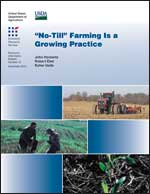"No-Till" Farming Is a Growing Practice
- by John Horowitz, Robert Ebel and Kohei Ueda
- 11/2/2010
Overview
Most U.S. farmers prepare their soil for seeding and weed and pest control through tillage-plowing operations that disturb the soil. Tillage practices affect soil carbon, water pollution, and farmers' energy and pesticide use, and therefore data on tillage can be valuable for understanding the practice's role in reaching climate and other environmental goals. In order to help policymakers and other interested parties better understand U.S. tillage practices and, especially, those practices' potential contribution to climate-change efforts, ERS researchers compiled data from the Agricultural Resource Management Survey and the National Resources Inventory-Conservation Effects Assessment Project's Cropland Survey. The data show that approximately 35.5 percent of U.S. cropland planted to eight major crops, or 88 million acres, had no tillage operations in 2009.
Download
-
Entire report
Download PDF -
Report summary
Download PDF -
Download EIB70.zip
Download ZIP

